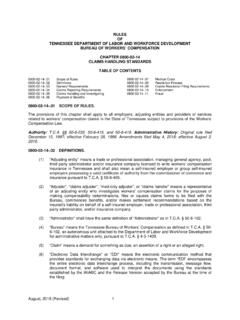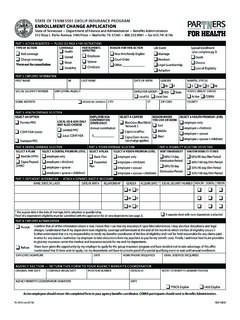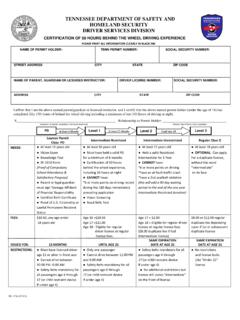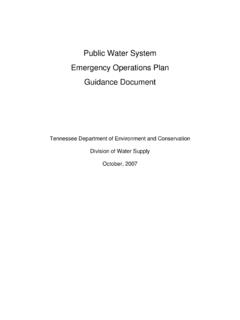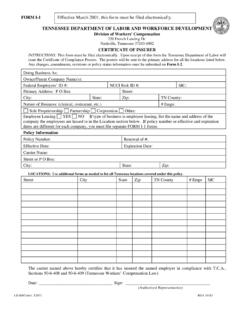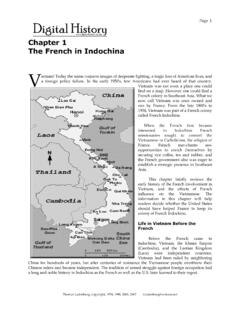Transcription of The Trail of Tears in Tennessee: A Study of the Routes ...
1 The Trail of Tears in tennessee : A Study of the Routes Used During the Cherokee Removal of 1838. 2001. THE Trail OF Tears IN tennessee : A Study OF THE Routes USED. DURING THE CHEROKEE REMOVAL OF 1838. Benjamin C. Nance tennessee Department of Environment and Conservation Division of Archaeology 2001. TABLE OF CONTENTS. List of Figures ii List of Tables iii Acknowledgments iv Introduction 1. An Overview of Historical Events Leading to the Removal of the Cherokees 3. Results of the Survey of Routes Used By the Cherokees 21. During Their 1838 Removal From tennessee Departure Points 23. Northern Route 27. Bell's Route 33. Benge's Route 38.
2 Taylor and Brown's Route 40. Drane's Route 42. Archaeological Remains Related to the Trail of Tears 43. Conclusions 45. Appendix A. Recorded tennessee Archaeological Sites Pertaining to the Cherokees 47. Appendix B. Selected Photographs of Road Segments 56. Appendix C. Maps of the Removal Routes in tennessee 60. References Cited 68. LIST OF FIGURES. Page Figure 1. Map of the Cherokee Nation in 1721 6. Figure 2. Map of the Cherokee Nation 1819-1835 7. Figure 3. General Map of the Land Routes Used During the Cherokee Removal 18. Figure 4. Map of the Fort Cass Emigrating Depot 24. Figure 5. Cannon County. Road segment beside Highway 70S in Leoni 57.
3 Figure 6. Robertson County. Road Segment near Harmony Church Road 57. Figure 7. Franklin County. Road Segment West of Winchester (facing east) 58. Figure 8. Franklin County. Road Segment West of Winchester (facing west) 58. Figure 9. Hardeman County. Road Segment Near Stewart Road 59. Figure 10. Humphrey's County. Portion of Old Road Near Conal co Road 59. ii LIST OF TABLES. Page Table 1. Removal Detachments, Their Conductors, Assistant Conductors, 16. and Probable Points of Departure Table 2. Recorded tennessee Archaeological Sites Pertaining to the Cherokees 48. iii ACKNOWLEDGMENTS. Reports of this kind are not possible without the help of many people providing information, advice, and technical assistance.
4 Several people aided in completion of the project that this report concerns, and their help is greatly appreciated. The tennessee Division of Archaeology's Trail of Tears project originated from conversations between Division Director Nick Fielder and members of the tennessee chapter of the Trail of Tears Association. Realizing the need for a comprehensive Study of all portions of the trails used by the Cherokee during the removal, Nick conceived the idea for a statewide Study to map out the Routes of the removal detachments and look for surviving segments of the roads. Sam Smith, Historical Archaeologist for the tennessee Division of Archaeology, offered advice during the early planning stage of the project and later helped conduct field examinations of the Routes in various parts of the state.
5 Sam also edited the site forms for the sites recorded during the survey, as well as the final report. His input and guidance throughout the project were vital to the completion of the work. Suzanne Hoyal, Site File Curator for the tennessee Division of Archaeology, also participated in the early planning stage for the project. Later she assigned site numbers to each of the recorded sites and processed them for inclusion in the statewide archaeological site file. Steve Rogers of tennessee Historical Commission was responsible for the administration of the Survey and Planning Grant that was used to fund this project. The tennessee Division of Archaeology provided matching funds in the form of salaries of staff members who helped with the project and by providing the Division's vehicles and equipment.
6 The tennessee chapter of the Trail of Tears Association is an organization dedicated to preserving the history of the Cherokee Removal, and its members have done much research on the subject. Several members of this organization provided inspiration, assistance, and information used in conducting this survey project. Bill Jones of Spencer, tennessee helped Nick Fielder develop the idea of conducting a statewide survey to locate the Routes used by the Cherokees during their removal. Mr. Jones has done extensive research on this subject, and he graciously shared his information with the Division of Archaeology staff. Floyd Ayres of Winchester, tennessee also shared his research information concerning the route of the Bell Detachment through Marion and Franklin Counties.
7 Mr. Ayres took the time to show researchers this route and provided some archival map information. The help of all members of the tennessee chapter of the Trail of Tears Association is appreciated. Tim Woods of Sewanee, tennessee took time to show researchers road segments near his home. He also introduced us to Joe Yokely, a resident of the Sewanee area, who shared his knowledge of the area. Mrs. Gladys Higgins, Mrs. Verna Higgins Wood, and Mrs. Marian Presswood, provided information concerning the location of Fort Marrin the Old Fort, tennessee area. Several landowners also graciously allowed us access to their private property for field survey of road segments.
8 Iv INTRODUCTION. The Term Trail of Tears has come to encompass the overall process of the removal of Indian tribes from their ancestral homes to territories west of the Mississippi River. Over the course of several decades beginning in the 1790s, the United States Government pursued a policy aimed at obtaining land from the Indian tribes that then lived east of the Mississippi River. The policy ultimately resulted in the Indian Removal Act of 1830, which had been strongly advocated by President Andrew Jackson. During the next five years the government sought treaties with the individual tribes to finalize the process of removing the Indians.
9 The smaller, less organized tribes of the north gave little resistance, but the five large southern tribes, Cherokee, Chickasaw, Creek, Choctaw, and Seminole, strenuously resisted removal. The Cherokees were the last to sign a treaty of removal, and that treaty, signed in 1835, was signed by a minority faction whose authority was questionable. The Cherokees continued to resist until 1837, when the United States Army began to round them up and place them in stockades and camps to prepare them for a forced removal. John Ross, Principal Chief of the Cherokees, came to an agreement with General Winfield Scott, commander of the removal forces, that the Cherokees would remove themselves under Ross's supervision.
10 In 1838 the Cherokee people began their journey to the west. The Trail of Tears is often thought of as one specific Trail or road on which thousands of Cherokees walked to their new home in what is now Oklahoma, but the reality is much more complex. Approximately 16,000 Cherokee people, with a handful of Creek Indians and black slaves, traveled in 17 different detachments using three main land Routes , several route variations, and a river route. Traveling by foot, wagon, and horse, some of the Cherokees were on the road for more than three months, most traveling in winter. Although there are no accurate records for the number of deaths resulting from the removal, the estimate of 4,000 deaths during the process of internment and removal is widely accepted.
